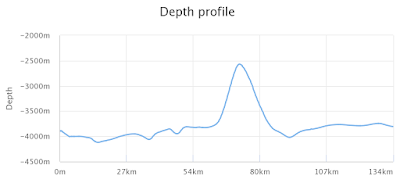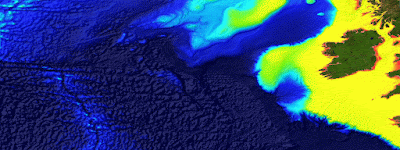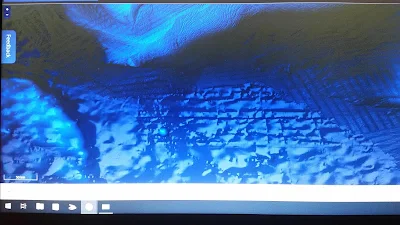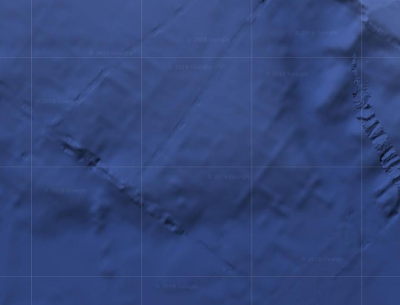63.455426 -54.318756
Thule (/ˈθjuːliː/ THEW-lee[1] Greek: Θούλη Thoúlē, Latin: Thūlē) is the farthest north location mentioned in ancient Greek and Roman literature and cartography. Modern interpretations have included Orkney, Shetland, the island of Saaremaa (Ösel) in Estonia,[2][3] and the Norwegian island of Smøla.[4]
and were all wrong, In classical and medieval literature, ultima Thule (Latin "farthermost Thule") acquired a metaphorical meaning of any distant place located beyond the "borders of the known world".[5] By the late middle ages and early modern era, the Greco-Roman Thule was often identified with the real Iceland or Greenland. Sometimes Ultima Thule was a Latin name for Greenland, when Thule was used for Iceland.[6] By the late 19th century, however, Thule was frequently identified with Norway.
In the early seventh century, Isidore of Seville wrote in his Etymologies that:
Ultima Thule (Thyle ultima) is an island of the Ocean in the northwestern region, beyond Britannia, taking its name from the sun, because there the sun makes its summer solstice, and there is no daylight beyond (ultra) this. Hence its sea is sluggish and frozen.[42]
Isidore distinguished this from the islands of Britannia, Thanet (Tanatos), the Orkneys (Orcades), and Ireland (Scotia or Hibernia).[42] Isidore was to have a large influence upon Bede,[43] who was later to mention Thule.
By the late Middle Ages, scholars were linking Iceland and/or Greenland to the name Thule and/or places reported by the Irish mariner Saint Brendan (in the 6th century) and other distant or mythical locations, such as Hy Brasil and Cockaigne. These scholars included works by Dicuil (see above), the Anglo-Saxon monk the Venerable Bede in De ratione temporum, the Landnámabók,[citation needed] by the anonymous Historia Norwegie,[citation needed] and by the German cleric Adam of Bremen in his Deeds of Bishops of the Hamburg Church, where they cite both ancient writers' use of Thule as well as new knowledge since the end of antiquity. All these authors also understood that other islands were situated to the north of Britain.
Eustathius of Thessalonica, in his twelfth-century commentary on the Iliad, wrote that the inhabitants of Thule were at war with a tribe whose members dwarf-like, only 20 fingers in height.[44] The American classical scholar Charles Anthon believed this legend may have been rooted in history (although exaggerated), if the dwarf or pygmy tribe were interpreted as being a smaller aboriginal tribe of Britain the people on Thule had encountered.[45]
Petrarch, in the fourteenth century, wrote in his Epistolae familiares ("Familiar Letters") that Thule lay in the unknown regions of the far north-west.[46]
A madrigal by Thomas Weelkes, entitled Thule (1600), describes it with reference to the Icelandic volcano Hekla:
Thule, the period of cosmography,
Doth vaunt of Hecla, whose sulphureous fire
Doth melt the frozen clime and thaw the sky;
Trinacrian Etna's flames ascend not higher ...[47]
The English poet Ambrose Philips began, but did not complete, a poem concerning The Fable of Thule which he published in 1748.
Thule is referred to in Goethe's poem "Der König in Thule" (1774), famously set to music by Franz Schubert (D 367, 1816), Franz Liszt (S.531) and Robert Schumann (Op.67, No.1), and in the collection Ultima Thule (1880) by Henry Wadsworth Longfellow.
Modern literature
Edgar Allan Poe's poem "Dream-Land" (1844) begins with the following stanza:
By a route obscure and lonely,
Haunted by ill angels only,
Where an Eidolon, named Night,
On a black throne reigns upright.
I have reached these lands but newly
From an ultimate dim Thule –
From a wild weird clime, that lieth, sublime,
Out of Space – out of Time.
John Henry Wilbrandt Stuckenberg wrote on the subject in 1885:
What is the mind’s ultima Thule? What substance must be regarded as first, and therefore as the seed of the universe? What is the eternal Something, of which the temporal is but a manifestation? Matter? Spirit? Matter and Spirit? Something behind both and from which they have sprung, neither Matter nor Spirit, but their Creator? Or is there in reality neither Matter nor Spirit, but only an agnostic Cause of the phenomena erroneously assigned by us to body and mind?
After spending many years in profoundly investigating this problem, I have at last struck bottom. Unhesitatingly and unconditionally I adopt materialism, and declare it to be the sole and all-sufficient explanation of the universe. This affords the only thoroughly scientific system; and nowhere but in its legitimate conclusions can thought find suitable resting-place, the heart complete satisfaction, and life a perfect basis. Unless it accepts this system, philosophy will be but drift-wood, instead of the stream of thought whose current bears all truth. Materialism, thorough, consistent, and fearless, not the timid, reserved, and half-hearted kind, is the hope of the world.
— The Final Science: or Spiritual Materialism (1885) by John Henry Wilbrandt Stuckenberg (1835-1903), p. 6[48]
Ultima Thule is the title of the 1929 novel by Henry Handel Richardson, set in colonial Australia.
"Ultima Thule" is a short story written by author Vladimir Nabokov and published in New Yorker magazine on April 7, 1973.[49]
Jorge Luis Borges uses the classic Latin phrase "ultima Thule" in his poem A Reader[50]. He uses the phrase to connect the study of Latin in his younger years to his more recent efforts to read the Icelandic poet Snorri Sturluson.
In Nazi ideology
In Germany, extreme-right occultists believed in a historical Thule, or Hyperborea, as the ancient origin of the "Aryan race" (a term which they believed had been used by the Proto-Indo-European people). The Thule Society, which had close links to the Deutsche Arbeiter Partei (DAP), known later as the Nationalsozialistische Deutsche Arbeiterpartei (NSDAP or Nazi party) was, according to its own account, founded on August 18, 1918.[51] In his biography of Lanz von Liebenfels (1874–1954), Der Mann, der Hitler die Ideen gab, Munich 1985 – The Man who Gave Hitler the Ideas, the Viennese psychologist and author Wilfried Daim claimed that the Thule Gesellschaft name originated from mythical Thule. In his history of the SA (Mit ruhig festem Schritt, 1998 – With Firm and Steady Step), Wilfred von Oven, Joseph Goebbels' press adjutant from 1943 to 1945, confirmed that Pytheas' Thule was the historical Thule for the Thule Gesellschaft.
Much of this fascination was due to rumours surrounding the Oera Linda Book, falsely claimed to have been found by Cornelis Over de Linden during the nineteenth century. The Oera Linda Book was translated into German in 1933 and was favored by Heinrich Himmler. The book has since been thoroughly discredited. Professor of Frisian Language and Literature Goffe Jensma wrote that the three authors of the translation intended it "to be a temporary hoax to fool some nationalist Frisians and orthodox Christians and as an experiential exemplary exercise in reading the Holy Bible in a non-fundamentalist, symbolical way".[52]
https://ediovision.blogspot.com/2019/01/city-of-vineta-4.html
City of, "Vineta"
he's only gone and found another lost city "Vineta", this one's not even that deep
(þú gætir haft kafara á staðnum innan klukkutíma og verið í Vineta áður en þú þekkir það)
Depth min 43.68m
Depth max 45.12m
Depth average 44.42m
Depth standard deviation 0.45
Elementary surfaces 11
Depth smoothed 40.86m
Depth smoothed offset 3.5600000000000023
DTM Source 1215_EEZ20
Latitude 61.79150390625001
Longitude 18.906372078694407
N
W

E
S
i spent a while mapping out the feature and believe it or not this representations is actual almost 100 accurate
looking E .W. E
Lost Ancient Golden City Of Vineta – The Atlantis Of The North Many have tried to find the legendary ancient golden city of Vineta, but up until now thanks to your's truly, the location of the place is now a solved mystery.Lost Ancient Golden City Of Vineta – The Atlantis Of The North
academics and scholars think Did Vineta really exist or was is it only a mythical city? Do the ancient ruins of Vineta lie hidden somewhere beneath the water of the Baltic Sea? (yes and i'm going to proove it)
Today, Vineta has become known was the Atlantis of the North and people still go to the beach with hope the they will catch a glimpse of the ancient underwater city. but its not like its a ways from the beach
Ancient stories tell Vineta was once a very prosperous trading center somewhere on the Baltic Coast. During the late 12th century it disappeared beneath the water. Legend tell Vineta’s inhabitants ignored omens of a coming disaster and the city was submerged as punished for moral decay.
Vineta Was A Prosperous Ancient Trading Center
According to legends, Vineta was visited by traders from many corners of the world. It was one of the most important ancient commercial cities in Europe and visited by Vikings, Slavs, Spaniards, Saxons, people from the Mediterranean and business men from surrounding Baltic regions
Ancient city of Vineta was flourishing and news about the city reached people in distant parts of the world. Ibrahim Ibn Yaqub, a 10th-century Hispano-Arabic, Sephardi Jewish traveler, who was probably a merchant and may also have been engaged in diplomacy and espionage described it as “a large city by the ocean with twelve gates, the greatest of all cities in Europe, farthest north-west in the country of Misiko (Poland) in the marshes by the ocean.
It is said that Vineta had a population of at least 50,000 inhabitants and the city was even richer than Constantinople.
Warnings Of A Coming Disaster Were Ignored,
(sounds familiar)
According to legend, three months, three weeks, and three days before the destruction of the city all people were warned of the coming catastrophe. Strange bright lights were seen in the sky and wailing mermaid appeared. The water woman cried three times in a high, startling voice:
"Vineta, Vineta, you rieke town, Vineta sall untergahn, wieldse se het väl Böses dahn"
"Vineta, Vineta, rich city, Vineta is to be destroyed because she has done much evil."
Even today, bells from the depths of the sea will be heard.
Elders advised all people to leave the city, but everyone was reluctant to abandon a place famous for its gold and wealth. Inhabitants of Vineta lacked modesty and had become greedy.
The city of Vineta was deluged in 1170 and vanished beneath the waves of the Baltic Sea. It was believed that Vineta had been destroyed as punishment for immorality.
Where Is Vineta – The Atlantis Of The North?
The location of Vineta remains a controversial subject and there are many disagreements where the legendary city was situated. Some researchers have suggested that Vineta may have been on Wolin, an island surrounded by the Baltic Sea to the north, the Dziwna River to the east. Archaeological excavations have revealed that Wolin was once a major Viking trading center.
but I'm going to give you all the details below
Latitude 61.79150390625001
Longitude 18.906372078694407





























































